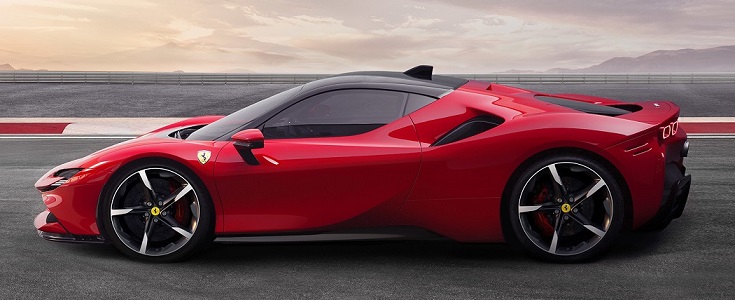

Coupe, 2 Doors, 2 Seats
780 Hp @ 7500 rpm.
195.5 Hp/l
340 km/h 211.27 mph
3990 cm3
243.48 cu. in.
8, V-engine
All wheel drive (4x4),
4710 mm
185.43 in.
1972 mm
77.64 in.
1570 kg
3461.26 lbs.
| Brand | Ferrari |
|---|---|
| Model | SF90 (Coupe) |
| Version | SF90 Stradale |
| Engine version | 4.0 V8 (1000 Hp) Plug-in Hybrid Automatic |
| Year production start | 2019 |
| Vehicle type | Coupe |
| Horsepower RPM | 780 Hp @ 7500 rpm. |
| Acceleration 0 - 100 kmh sec | 2.5 sec |
| Curb weight kg -lbs total |
1570 kg3461.26 lbs. |
| Overall length mm - inch |
4710 mm185.43 in. |
| Doors | 2 |
| Top Speed | 340 km/h 211.27 mph |
| Designation model | F154 FA |
|---|---|
| Engine position and orientation | Front axle, Transverse |
| Cylinders | 8 |
| Position of cylinders | V-engine |
| Displacement (liters) |
3990 cm3243.48 cu. in. |
| Eng. horsepower RPM | 780 Hp @ 7500 rpm. |
| Horsepower per litre | 195.5 Hp/l |
| Weight / horsepower kg/hp - hp/tons |
1.6 kg/Hp636.9 Hp/tonne |
| Weight / torque kg/Nm - Nm/tons | 2 kg/Nm, 509.6 Nm/tonne
2 kg/Nm509.6 Nm/tonne |
| Torque Nm RPM lb-ft RPM |
800 Nm @ 6000 rpm.590.05 lb.-ft. @ 6000 rpm. |
| Bore (mm in) |
88 mm3.46 in. |
| Stroke (mm in) |
82 mm3.23 in. |
| Compression ratio | 9.5 |
| Fuel delivery system | Direct injection |
| Fuel type | petrol / electricity |
| Valvetrain | 4 |
| Engine aspiration | Turbocharger, Intercooler |
| Emission certification | Euro 6d-ISC-FCM |
| Powertrain architecture | PHEV (Plug-in Hybrid Electric Vehicle) |
| Electric motor power | 135 Hp |
| Engine location | Front axle, Transverse |
| Total available power | 1000 Hp |
| Drive configuration | All wheel drive (4x4) |
|---|
| Front brakes | Ventilated discs, 398x38 mm |
|---|---|
| Rear brakes | Ventilated discs, 360x32 mm |
| Anti-lock brake system | ABS (Anti-lock braking system) |
| Steering type | Steering rack and pinion |
|---|
| Wheels size | Front wheel tires: 255/35 ZR20 |
|---|---|
| Wheels rims | Front wheel rims: 9.5J x 20 |
| Passengers seats | 2 |
|---|---|
| Trunk space max liter | cu. Ft. |
74 l2.61 cu. ft. |
| Overall length mm - inch |
4710 mm185.43 in. |
|---|---|
| Overall width mm -inch |
1972 mm77.64 in. |
| Overall height mm -inch |
1186 mm46.69 in. |
| Wheelbase mm - inch |
2560 mm100.79 in. |
| Track width front mm - inch |
1679 mm66.1 in. |
| Track width rear mm - inch |
1652 mm65.04 in. |
| Curb weight kg -lbs total |
1570 kg3461.26 lbs. |
|---|
| Combined fuel consumption (WLTP) | 6.0-6.1 l/100 km 39.2 - 38.56 US mpg |
|---|
8 CYLINDER V-Engine
https://www.thecarspec.net/components/engine/8-cylinders-v